|
REBUILDING A WARTIME BUS
BY MARY CARDWELL
Some of our readers may remember the `comforts' of
travelling in wartime `Utility' buses. Those who do not may
still be able to find out for themselves, as one of these
`Utility' or `Austerity' buses has been reconstructed, and
it has links with Dromore.
Through the years, men from Dromore have been employed in
the different bus companies which have served the area. They
worked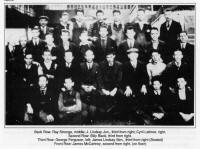 not only as drivers and conductors, but also in the various
trades involved in building and maintaining the buses.
not only as drivers and conductors, but also in the various
trades involved in building and maintaining the buses.
After the First World War, as ex-service vehicles and men
became available, there was a rapid expansion in the use of
motor vehicles for commercial transport. At this time, as
there were no controls a large number of small operators,
each owning just a few buses, competed for passengers with
each other and with the railways. In 1926 the Northern
Ireland Government introduced legislation requiring that
vehicles, drivers and conductors be licensed. Similar
regulations were adopted in England four years later.
The two largest of the bus companies were the Belfast
Omnibus Company and H.M.S. Catherwood, which, between them,
covered most of Northern Ireland as well as express services
to Dublin and Cork. Although engines and chassis were
acquired from England, both companies constructed some of
the bodies for their buses in their own workshops. Many
Dromore men found work with these companies. A photograph
taken in the University Street depot of the Belfast Omnibus
Company in 1932, shows a number of Dromore men.
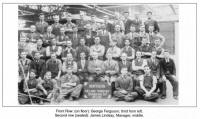 Competition
from the buses had an adverse effect on the railways, and in
August 1935 the Northern Ireland Road Transport Board was
set up to take over all bus companies (except Belfast
Municipal Transport) and `co-ordinate' road and rail
transport. N.I.R.T.B. continued to build some bus bodies in
its Duncrue Street workshops. Competition
from the buses had an adverse effect on the railways, and in
August 1935 the Northern Ireland Road Transport Board was
set up to take over all bus companies (except Belfast
Municipal Transport) and `co-ordinate' road and rail
transport. N.I.R.T.B. continued to build some bus bodies in
its Duncrue Street workshops.
The outbreak of the Second World War led to a rapid
increase in passenger traffic as fuel shortages restricted
private transport. Initially the extra vehicles needed were
hired, but from 1942 onwards a limited number of new buses
became available. The standard wartime single deck bus was
the Bedford OWB with its uncompromisingly severe utility
bodywork. A total of 175 of these buses entered service with
the N. I. R. T. B. between 1942 and 1945. All were
withdrawn, and sold, between 1948 and 1950 when standardised
post-war buses became available.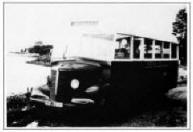
Postwar, the Ulster Transport Authority was created to
take over the NIRTB and the various railway companies, and
by the late 1950's the UTA had a legal monopoly of all
commercial land transport, road and rail, passenger and
freight. The authority continued production of standard
single-deck buses, and double deck were also built 1955
until about 1962, when the move to one-man operation once
again favoured the single-deck bus.
In the mid 1960's the Transport Industry was reorganised
once again. The UTA was replaced by the Northern Ireland
Transport Holding Company and its road freight, rail and bus
services passed to subsidiary companies while its hotel
business was sold. The buses were taken over by Ulsterbus
Ltd in April 1967.

1985 was the 50th anniversary of public ownership of road
passenger transport in Northern Ireland and the Ulsterbus
company decided to mark this in a special way. One chosen
project, to recreate an old bus, was a completely new
venture for Ulsterbus. Some people thought it would be
impossible, but they reckoned without the enthusiasm, skill
and imagination of the Duncrue Street folk.
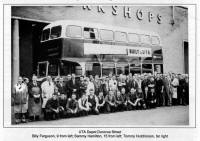 As
their name suggests, utility buses were built with economy
in mind to ease the shortage of public service vehicles
during the war. They could be put on the road for just under
�600. An extract from `The Transport World' dated September
10, 1942, gives a description of the buses which may jog a
few memories. As
their name suggests, utility buses were built with economy
in mind to ease the shortage of public service vehicles
during the war. They could be put on the road for just under
�600. An extract from `The Transport World' dated September
10, 1942, gives a description of the buses which may jog a
few memories.
"Particular points of economy are the brown semi-gloss
primer finish and the wood-slatted seats. Beaten panels are
eliminated from the roof, two windows only are made to open,
and no interior panelling is provided.
Travel in these vehicles is not uncomfortable, however,
as the wooden seats are well shaped, and the excellently sp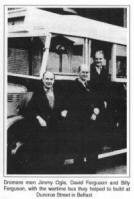 rung
Bedford chassis ensures a minimum of jarring." rung
Bedford chassis ensures a minimum of jarring."
After the war, all the utility buses in Northern Ireland
were sent back to England, where many had more sophisticated
coach bodies put on them. One found its way back to Belfast
again, but came to a rather inglorious end, as a hen house
in the Castlereagh Hills. It was eventually tracked down by
Ulsterbus, and transported gingerly to Duncrue Street, where
the work of restoration began.
Three Dromore men took part in recreating history at the
Ulsterbus maintenance depot, Duncrue Street, Belfast. Billy
Ferguson, David Ferguson and Jimmy Ogle helped to build an
exact replica of a Bedford OWB Utility Bus, which would have
been a familiar sight around the country during the Second
World War.
In all, about a dozen men worked on the bus, relying
heavily on personal memories, as well as photographs and old
documents to get the details just right. The Dromore trio
brought to the project years of experience in bus
maintenance and mechanics, and also added a more elusive
ingredient - their own memories of those wartime buses.
First the old body was taken off and discarded, and the
chassis and reconditioned engine were reinstated. Then the
men set about building, from new materials, a body identical
to the one the chassis had when it began its duty in Co.
Down in 1942.
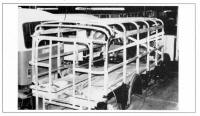 |
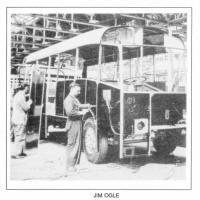 |
Next came the body
builders, sheet metal workers, fitters, and
painters, all enjoying a break from the routine
work on modern buses. David Ferguson was
involved in restoring the iron work, and Jimmy
Ogle worked on finishing the inside of the bus. |
| The
original wooden frame had rotted and had to be
replaced. Billy Ferguson first `struck out' the
frame in plywood to make sure all the
measurements were correct. He then made up the
new frame and pillars out of ash wood. |
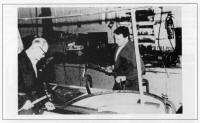 |
For some of the team, it was
like stepping back to their apprenticeship days,
for they had started their working lives on the
utility bus.
|
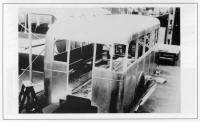 |

The project captured the imagination of everyone at the
depot, and even those not actually working on it often came
over to watch as it took shape. As news spread, more
information flooded in about utility buses. One man who had
used a wooden seat from an old bus as a garden seat for
years brought it in and the team were able to model the rest
of the seats on it. Another enthusiast donated a destination
blind.
The finished bus, which Mr. Laverty, the foreman
coachbuilder described as going "Like a sewing machine",
featured on the back cover of the commemorative book*
produced to mark the 50th anniversary.
Dromore people were given a chance to admire the
handiwork of their fellow townsmen when the completed bus
visited the Dromore Horse Fair in 1986. It is now in
safekeeping with Ulsterbus and is still used for special
events during the summer months.
Another interesting project in which Dromore men were
involved was in building a `mini' bus. This working scale
model of a double decker bus was built in 1947. Frank Sefton
and Billy Ferguson did the `marking out' of the wood work
while Geordie Ferguson, who was quite small did the work on
the inside of the bus.
This `mini' bus is now in the Ulster Folk and Transport
Museum. * Fifty Years of Public Service by G. I. Millar.
I wish to acknowledge Mr. Wm. Ferguson and Mr. G. Millar of
Ulsterbus for their kind assistance in the preparation of
this article, and permission to use Ulsterbus copyright
photographs.

WARTIME VISITORS
BY MARY CARDWELL
During the Second World War many servicemen and women,
came to Northern Ireland. Not all of them were total
strangers however, having relatives, friends, or `friends of
friends' in this area.
One such instance originated from the friendship between
a shop owner in Dromore and another in Manchester. Mr.
George McCalister, who owned a shoe shop in Dromore was
friendly with Mr. William Walker from Manchester, who also
had a shoe shop. When Harold Lantsbury, a relative of Mr.
Walker's was sent to Northern Ireland with a RAF unit he
came to visit Dromore. Other members of the unit came too,
and became quite regular visitors. They got to know some of
the local people and a few kept in touch, even after the
War. Two of them have contributed some memories of those
days.
Dromore 1941 by a
Foreigner
In the Spring of 1941 I was serving with the R.A.F.
Central Medical Establishment in London. I was called into
the C.O.'s office and told that a small unit was to be
formed to operate in Northern Ireland. In order to maintain
the highest secrecy half the unit (Eight Officers and three
N.C.O.s with a further three W.A.A.F.) would be from CME and
the other half from Manchester. We all met at R.A.F.N.U. (Stormont)
and were then allocated a large house in the Antrim Road. In
conversation with my opposite number from Manchester (I can
only remember him as Harold) I learned that he had friends
in Dromore he intended to visit on his first day off and he
asked me to join him.
So, on the next Sunday we caught a train in Belfast to
the unknown City of Dromore. (We decided that it had to be a
city as it had a Cathedral) He told me his friends were
named McCalister and they owned a local shoe shop.
We were greeted with great warmth and made very welcome.
The high-spot of that day was the food. Compared with
England there seemed to be plenty of all the lovely food we
had not seen for months. We ourselves in Northern Ireland
were living on army rations, made even worse because we had
to cook it ourselves!.
This first visit was followed by several more and we were
quickly drawn into the life of Dromore. After service on
Sunday we would go to Mrs. Stronge's house and, with her
daughters, Sadie and Mary would gather round the piano for a
sing song. I remember starting to sing `London Pride' but I
was stopped and told `That is not in the Hymn Book'.
I was asked by the Dromore St. John's Ambulance Brigade,
to talk to them about the air raids in London. This was a
subject about which I knew very little at that time but of
which I came to know a lot more later.
A very good friend at the time of our visits to Dromore
was Andy who was a journalist on a local paper. We also met
the verger of the Cathedral who proudly took us to the top
of the tower to see the view of the surrounding countryside
and to the ancient Mound.
I have none but pleasant memories of Dromore - in fact
somewhere in a hedge is a blackthorn stick which I tied up
to be collected in my old age. Alas I doubt if I shall ever
reclaim it.
E. S. (Sid) Broadbridge
Mrs. Morley, then Miss Terry Farrell was one
of the WRAF members of Mr. Broadbridge's unit. She writes:
When Sid Broadbridge took me along to Dromore we used
to alight from the train at the Halt and Walk to the
McCalister's house where we stayed the day or sometimes
overnight. On one occasion when we also had with us our
third member of the team from Central Medical
Establishment, London, Bernard Hanson, Sid actually
slept under the dining room table as the bedrooms were
all occupied!
We also called on other friends in Dromore from time
to time including Miss Robinson, a Schoolteacher. They
were all very kind to us and we certainly did appreciate
the food provided especially if there were cakes, which
were unobtainable in the main at home with the rationing
of so many things. I have no doubt they all had
difficulties in finding food to give us but of course
they never said anything. We only had Air Force food
which was not exactly liberal. As we usually stayed a
week each month in Belfast we tried to rush as quickly
as we could through our preparatory work on the Friday
we arrived and also worked full speed on Saturday with
the hope of paying a visit to Dromore on the Sunday. It
did not always work out but when we did it was a treat.
Miss Robinson sometimes provided us with tickets for a
Theatre. I have a stub of the ticket to the Belfast
Empire dated June 5th, the day before D Day, and the
programme showing the play `Night Must Fall' by Emlyn
Williams - price Grand Circle 3/6 d (17 1/2 p), the
Gallery 9d (4 1/2 p), Programme 2d (1p). I remember
very well the sheer discomfort of train travel to
Holyhead when we came by boat. What with the cold - snow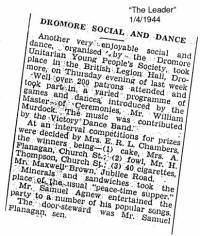 on the ground - the only heat coming from being so
crowded. We could not get seats and sat on luggage in
the corridor, which meant getting up every time anyone
wanted to pass. No food or drink except what you
carried. The old boats were pure luxury after that. We
once proceeded back through the Larne - Stranrar route
which meant a long uncomfortable night by train to
London during which time Bernard was hit on the head by
a soldier's tin hat falling on his head and we reported
to CME with one casualty of the journey!
on the ground - the only heat coming from being so
crowded. We could not get seats and sat on luggage in
the corridor, which meant getting up every time anyone
wanted to pass. No food or drink except what you
carried. The old boats were pure luxury after that. We
once proceeded back through the Larne - Stranrar route
which meant a long uncomfortable night by train to
London during which time Bernard was hit on the head by
a soldier's tin hat falling on his head and we reported
to CME with one casualty of the journey! Sometimes we
did get a plane, to the Air Field called "Nutts Corner"
just outside Belfast from either Hendon, near London, or
Doncaster, where we picked up the Radiographer group of
3 or 4. This was the first time I ever wore trousers as
there
were no steps into the aircraft and I had to be heaved
up with a push behind from Sid. Also we had to put on a
parachute which needs a trouser outfit. We did have a
good laugh on one occasion when we were provided with a
Mae West but no parachute and wondered about the time
between leaving the aircraft and hitting water!
Looking back it all seems a bit hit and miss, but
when you are young none of this is worrying.

PALIMPSEST
BY ROY GAMBLE "A parchment on which one lot
of writings was scraped away to make room for the next."
On the ordnance survey map the loaning is marked with a
stubby double-line symbol measuring a mer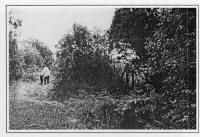 e
halfmilimetre. In reality, it windsfor nearly a mile, an
overgrown, rutted cart-track, meandering from the summit of
B-1- Hill down to the Drumbroneth/Ballaney road. e
halfmilimetre. In reality, it windsfor nearly a mile, an
overgrown, rutted cart-track, meandering from the summit of
B-1- Hill down to the Drumbroneth/Ballaney road. In
England it would be called a lane. In Gaelic speaking
Ireland, a boreen. Here in the heart of Down, following the
custom of the Scottish influence, we prefer loaning.* The
older inhabitants of the area, in memory of a family who
lived here once, employed the lengthier version of "Gourleys'
Loaning. "We of a later generation referred to it simply as
"The Loaning." From the top, near where it joins Barban
Hill road, the view encompasses a vast arc of countryside.
In the distance, almost directly ahead, looms the fissured
mass of Slieve Croob. To the right and much further away the
faded blue Mournes trundle dimly along the horizon. Much
nearer, down and across to the left, the spiralling smoke
and clustered chimney pots of Dromore are silhouetted on the
rim of the town's encircling ridge. Nearer still, on
neighbouring hills, no-nonsense Ulster farm-houses, holding
the same position they have held for over a century, squat
in their protective huddle of trees. Below, on the
Drumbroneth road, a line of detached cottages wink their
windows in the afternoon sun. Further down the loaning,
rising mysteriously from the nearby tractor pampered
grassland in a juxtaposition of ancient and modern, stands
an iron-age rath, its crumbling circle-bank ringed with
gnarled oaks, the Druid's sacred tree which once covered all
of Celtic Ireland. Here, well before the birth of Christ,
some early hunter-gatherer/come farmer scratched a living,
retreating at night with his stock to his crude dwelling
behind the fenced ramparts. But this has long been colonist
land; the vast oak forests felled by the incomers hand, the
soil broken with plough and harrow by generations of
settler/farmers: Brown and Baxter, Gamble and Jamison,
Prenter and Carlisle. To the practiced eye, each patch of
greenery, each rectangle of field tells its own history. And
just as one set of writings on an ancient manuscript
emerges, faint and barely detectable from under fresher
writings, so the traceable remains of the shape and
structure of the old land and the old ways emerge from newer
shapes contrived by a more modern methods of agriculture:
there a hedge torn out, running two fields into one; here a
rushy meadow drained and ploughed, changing forever the
pattern of the countryside. Winding through all this;
dividing the spread of walled and hedged farmland, is the
loaning. It is an oasis of peace, its timelessness unchanged
and unspoiled, its memories unvioliate. To walk its slow
length in the somnolent heat of a summer day is to be
enveloped in a time-warp; a piece of lost Celtica, where the
oak, the ash and the wild dog rose; alive with robin,
blackbird, thrush and linnet-all representatives of the
loveliness of nature once worshipped by the ancients who
pitched their scattered settlements of wattle-walled
clachans in these gentle drumlins. The tumbled stone and
mortar walls of much later settlements remain forlornly at
the loaning side, overgrown now with nettle and briar and
ivy. The names of their long departed occupants ring out
like old English sea captains who might have cruised the
Spanish Main with Drake, or took the Americans with Raleigh;
Kydd and Haskins and Mount. All this land that the loaning
lies at the heart of is an historic metophorical palimpsest,
scarred by the evidence of centuries of occupation by Celt
and Gael and planter, extending right up to the present day.
Every indentation in hedge, every mark in flanking field is
remembered, for we too have left our signature. Here we
picked blackberries in white enamel pails, and drugged with
sun, climbed the loaning to barter for the price of a cinema
ticket in Herbie McDonald's shop near the old Banbridge
road. In these fields, running each side of the loaning,
my father, following the gentle plodding Clydesdales, tied
hay and corn in their season.
Flax was retted in this dark weed-choked pool, its pungency
coating the air for days.
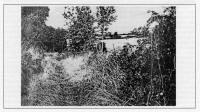 n
this sheltered snuggery among the blackthorn bushes, the
tinkers made camp, the smoke from their wood fires mingling
with the first cool earthy smells of Autumn. Scents of
childhood are still retained, hermitically sealed within the
loaning's tangled hedges. They hang, heavily aromatic, in
the closeness of the Summer air: the heady musk of
cow-parsley, the sweet froth of elder, the cool dark
rankness of fern. All combining to evoke memories of that
concentrated conjecture that once accompanied a dreamy
adolescent, teetering precariously on the brink of young
manhood; whistling mournfully across the familiar fields or
loitering abstractedly in the loaning, the big wide world
beckoning: awesome and unknown and stretching invitingly;
luring him irrevocably away - half wanting to remain, half
wanting to go - from all that he knew and loved. n
this sheltered snuggery among the blackthorn bushes, the
tinkers made camp, the smoke from their wood fires mingling
with the first cool earthy smells of Autumn. Scents of
childhood are still retained, hermitically sealed within the
loaning's tangled hedges. They hang, heavily aromatic, in
the closeness of the Summer air: the heady musk of
cow-parsley, the sweet froth of elder, the cool dark
rankness of fern. All combining to evoke memories of that
concentrated conjecture that once accompanied a dreamy
adolescent, teetering precariously on the brink of young
manhood; whistling mournfully across the familiar fields or
loitering abstractedly in the loaning, the big wide world
beckoning: awesome and unknown and stretching invitingly;
luring him irrevocably away - half wanting to remain, half
wanting to go - from all that he knew and loved.
* LOANING -A lane: An open space for passage left
between fields of corn.

THE
BREAK OF DROMORE
BY SAM CAMPBELL The Break of Dromore was a
small battle in or near the town of Dromore on Thursday,
14th March, 1689. It is part of what would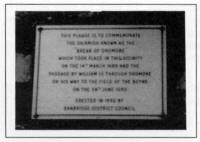 become known as the Williamite Wars in Ireland. It was
fought between units of the Irish Army led by General
Richard Hamilton and protestant adherents of the new English
King William III. Some of these protestants are named for us
as Lord Mountalexander from Comber; Colonel Upton; Major
Baker; Captain Magill and Sir Arthur Rawdon from Moira. The
word break is a Scottish word meaning a rout. It was these
protestant forces that were routed in the skirmish at
Dromore. While the Break of Dromore was a small local event,
its causes went deep into Irish history and the conflict of
which it was a part began with events in England and in
Europe.
become known as the Williamite Wars in Ireland. It was
fought between units of the Irish Army led by General
Richard Hamilton and protestant adherents of the new English
King William III. Some of these protestants are named for us
as Lord Mountalexander from Comber; Colonel Upton; Major
Baker; Captain Magill and Sir Arthur Rawdon from Moira. The
word break is a Scottish word meaning a rout. It was these
protestant forces that were routed in the skirmish at
Dromore. While the Break of Dromore was a small local event,
its causes went deep into Irish history and the conflict of
which it was a part began with events in England and in
Europe. In France the King was Louis 14th. Although small
in stature and a narrow minded bigot, he had a determination
to make France the most dominant power in Europe. He had
built up his country's strength and between 1672 and 1679
waged a successful war against his neighbour Holland. Other
European leaders especially those of the German states felt
threatened by Louis' actions. In times of trouble, the Dutch
states turned for leadership to the House of Orange. In 1672
the Prince of Orange was William, like Louis small in statue
but one of the great European statesmen of the century. He
built an alliance against Louis which included Holland,
Brandenburg, Hanover, Saxony, Bavaria, Savoy, Spain, The
Holy Roman Emperor and Pope Innocent XI who disliked Louis
attitude to papal power and his treatment of French
protestants, To strengthen this alliance William married
Mary daughter of the future King James II of England and
heir to the English throne. Through his wife Mary, William
on the death of her father would become ruler of England
with its wealth and power. In early 1688, Louis went to war
against this alliance, a war that lasted until 1697. The
Break of Dromore was a very small part of this great
European Conflict. The Break of Dromore was also a part of
the great events unfolding in England in the year 1688 which
would become known as the Glorious Revolution. James II had
come to the throne on the death of his brother Charles in
1685. Brought up as a protestant James had turned to the
catholic religion. His two daughters Mary and Anne were both
protestants and Mary as heir to the throne was married to
the champion of European Protestantism William Prince of
Orange. James II tried to rule as an absolute monarch and
succeeded in uniting against him people and parliament. In
June 1688 his second wife Mary of Modena gave birth to a
son. William and Mary would have no rights to the throne and
England faced a succession of catholic monarchs. There was
dismay in Holland and discontent throughout England. Three
weeks later leading English public figures wrote a vague
letter to William inviting him to come to England and
restore "true liberties". Freed from defending Holland by
Louis attack towards the German states and anxious to
prevent a catholic England with its wealth and powerful navy
from joining with France, William, with an army of 15,000
sailed for England landing at Torbay on the 5th November
1688. James fled to France and the English Parliament
invited William and Mary to rule England. But Ireland
stayed loyal to James who was still its legal king. In March
1689 with French money and soldiers James II landed in
Ireland hoping to use his Irish subjects as a stepping stone
to regain the throne of England. A small army was quickly
sent north to secure Ulster for James. It was this army that
clashed with the protestants at Dromore. In Ireland over
the century land ownership had changed hands between
protestants and catholic. In 1603 only 10% of the land was
in protestant ownership. By 1640 after the plantation of
Ulster this had risen to 40% and by 1688 after the
Cromwellian settlement, protestants owned 78% of the Land.
When James II became King of England, many dispossed
catholic land owners began to look to James to restore their
lands. Protestant landowners were alarmed. This alarm gave
way to fear when Richard Talbot, Earl of Tyroconnell, known
to protestants as Lying Dick, a catholic was made Lord
Lieutenant of Ireland. Against the law, Tyroconnell began to
sack protestant Judges and army officers and appoint
catholics in their place. When William landed in England in
1688 many protestants in Ulster began to look to him for
protection and military aid. Warned by Tyroconnells reforms
of the army and fearing a repeat of the events of 1641 when
thousands of protestants had been killed in the Great
Rebellion and taking encouragement from William landing in
England, protestant landowners had begun to raise and train
troops. In December 1688 protestant fears were increased by
the hoax Comber letter sent to their leader Mountalexander.

A few days later the gates of Derry were shut and Ulster
protestants were on the brink of rebellion. When James II
landed at Kinsale in March 1689 he was forced to hold a
parliament which restored all lands back to catholic
ownership. If they wanted to keep their estates, protestants
in the north would have to fight. In March General Hamilton
was sent north with a force of about 2000 soldiers to crush
protestant resistance. This protestant resistance in North
East Ulster was centred on Hillsborough. It was directed by
a Supreme Council with Lord Mountalexander of Comber as its
leader. The commander of the protestant forces was Sir
Arthur Rawdon of Moira. The Irish army under Richard
Hamilton had a simple task. It was to subdue Ulster and
prevent help arriving from England. To do this it would have
to capture Hillsborough and the ports on the east coast of
Ulster. Some where it would have to cross the river Lagan
and the most likely place to do this was at the ford in the
old cathedral town of Dromore. Sir Arthur Rawdon was
ordered to gather the protestant forces and concentrate them
at Dromore to guard the ford. The hills behind the Lagan
would give him a good defensive site. On Thursday, 15th
March, 1689 these two forces clashed at Dromore. There are
two main sources each giving a differing account of the
battle. In his book a History of the Presbyterian Church in
Ulster. Dr. Reid gives the following description of the
battle. On Monday, 11th March the Irish Army arrived at
Newry. Sir Arthur Rawdon with
drew his garrison from Rathfriland and he himself fell back
from Loughbrickland to Dromore, the protestant inhabitants
abandoning these towns. To Dromore came Captain Magill with
a troop of Dragoons and Major Baker with four companies of
foot soldiers. The protestant cavalry which was at
Hillsborough was not sent to Dromore. On Thursday, 14th
March units of the Irish army approached Dromore. Sir
Arthur Rawdon posted his foot soldiers under Major Baker in
the streets of Dromore to guard the ford over the Lagan. He
sent out his horse to reconnoitre the Irish army but
surprised by the swift movement of the Irish army the horse
hastily retreated and the foot gave way and fled. Many
inhabitants of Dromore were killed. Lord Mountalexander,
Colonel Upton and others marched to their support from
Hillsborough but were unable to rally their troops and a
general flight took place. The second account of the
battle was given by Alexander Colvill Webb in a letter to
the Nation Newspaper dated 1843. He says the fight took
place in the townland of Ballymacormic, the site being
bisected by the Belfast to Dublin road. It was on the south
side of Gallows Hill about 200 yards in front of Crow's
Wood. The left flank of the protestant forces was protected
by the common bog but their right flank was open to attack.
The protestant forces must have launched some form of attack
against the Irish army because according to Colvill Welsh
they were repulsed, then retreated into Crow's Wood and
dispersed over Cannon Hill. The words retreated and
dispersed do not suggest a rout. Colvill Welsh does not
believe that any of the inhabitants of Dromore were in the
fight or if they were none was killed "if any had been
killed in such a religious occurrence their graves to this
day would be pointed out .... as the present churchyard was
then the only burying place."
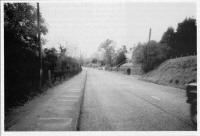 |
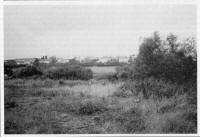 |
Possible Site of the Battle -
Area between Mossvale and Hillsborough Road (G.M.) |
 To say which is the correct version of the battle would
be impossible but from other shorter sources we can find
certain clues. It would be fair to say that the title of Dr.
Reid's book is the History of the Presbyterian Church in
Ireland while Colvill Welsh was writing about the Break of
Dromore and Colvill Welsh does attempt to explain why he
reaches certain conclusions. As Colvill Welsh says the
common bog would have given the protestant forces a secure
left flank and it is clearly marked on all the old maps of
Dromore. There is a description of Dromore dating from 1665.
"There are noe buildinge in this Parish onely at Dromore. It
beeing a Markett hath some old Thatcht houses and a ruined
church." A census for the 1659 suggests that the population
of Dromore was 48 Irish and 130 English and Scots. These two
sources do not support Dr. Reid's claim that the protestant
foot soldiers were in the streets of Dromore. It is
difficult to believe that twenty odd years after these
sources, Dromore would have been a town with many streets.
Colvill Welsh is correct in saying there are no graves from
this battle in the local churchyard. But that does not prove
that no inhabitants of Dromore were killed. Consider
following the battle of Aughrim 1691 the bodies of the Irish
were not buried after the battle, it seems unlikely that
protestant dead would have been buried in the churchyard.
There are no proven graves of any of the dead from this
battle. He is probably also correct in saying that few
Dromore people took part in this battle. It is likely that
the 48 Irish, catholics, had fled with the arrival of
Rawdons protestant forces. Of the 130 English and Scots many
were old men, young children, women and only a small number
would have been men of military age. In his account
Colvill Welsh claims that the protestant forces retreated
into Crow's Wood and dispersed over Cannon Hill. He is
supported in this by another local source. E. D. Atkinson in
his book Dromore an Ulster Diocese says. "Sir Arthur Rawdon
retreated with the remnants of his troops to Coleraine and
eventually Derry where they subsequently formed part of the
heroic garrison who held the city through the memorable
siege". We also know that Major Baker who commanded the
protestant foot soldiers at Dromore was one of the leading
figures in the siege of Derry. All of this does not support
the idea of a protestant force, routed by the Irish, fleeing
and being cut down by the Irish cavalry. However Alexander
Colvill Welsh gives us no details of the battle eg. names,
numbers involved. The protestant forces were clearly in
Dromore to guard the Lagan. But in Colvill Welsh's account
they do not appear to have occupied the Norman Mound or the
old stone castle built by previous generations of soldiers
to prevent a crossing of the ford. By moving up Gallow's
Hill towards Crow's Wood their pikemen could not stop the
Irish crossing the river and their muskets would have been
almost out of range. They had lost their reason for being in
Dromore and the battle before the first shots were fired.
Major Baker who commanded the foot was a soldier by
profession and in Derry showed he was a very capable
officer. Dr. Reid claims the protestant foot was posted in
the streets of Dromore. While the word streets may cause us
some concern it does seem a good place to station soldiers
guarding the ford and taking advantage of any cover given to
them by the houses. Three other sources seem to support Dr.
Reid's version of the battle. E. D. Atkinson in Dromore an
Ulster Diocese say "Hamilton rapidly advancing fell upon
them and drove them in upon the main body of foot massed in
the town .... seized with panic they broke and fled and
numbers were ridden down and slain by their victorious
pursuers". This is very close to Dr. Reid's version of the
battle. Dr. Reid claims that even before the battle, many
inhabitants of Dromore had fled. This letter dated 6th
December, 1688 seems to prove he was correct. "the English
and Scots are under such apprehensions of fear that the
Irish will rise and kill them that many families have
removed themselves and gone to Newtown and many people have
removed their wives and goods to Portaferry". Also in this
book Jacobite Ireland the leading historian of the
Williamite Wars J. G. Simms writes" The protestants appear
to have mismanaged matters; the pick of their cavalry did
not arrive in time, and the infantry in clanger of being
surrounded by Hamilton's horse saved themselves by flight".

Whichever account of the battle is correct it is clear the
protestants forces suffered a severe defeat at Dromore.
There are a number of reasons for this. Bad leadership was
an important factor. The protestants of North East Ulster
had formed a Supreme Council with Lord Mountalexander at its
head, but as J. G. Simms says "Mountalexander was an
ineffective leader and his associates quarrelled with one
another". What the quarrelling was about we do not know but
it led to the fatal failure to concentrate all available
protestant forces at Dromore. It was not until after the
battle that Mountalexander, Colonel Upton and others marched
to Dromore. The pick of the protestant cavalry never reached
Dromore and there were other protestant garrisons throughout
counties Down and Antrim that surrendered after the battle
at Dromore without firing a shot. The quarrelling between
the protestant leaders can even be seen after the battle.
Sir Arthur Rawdon marched to Derry but Mountalexander
escaped to the Isle of Man. It is interesting to note in
passing that after the defeat at Dromore and during the
siege of Derry effective control of the protestant forces
passed from the nobility into the hands of the `common'
people such as the Rev. George Walker a Church of Ireland
Rector, Major Henry Baker, Adam Murray even though Sir
Arthur Rawdon was at Derry. Another important factor in
the protestant defeat was the number and quality of the
soldiers on both side. The Irish army numbered between 1500
and 2500 soldiers. These, although not well equipped or
often paid, were units of the regular standing army and in
later clashes such as the Boyne they proved to be good
soldiers. Against this force the protestants were raw,
untrained and undisciplined. They were also small in number
and easily outnumbered by the Irish Army. Protestant forces
at Dromore seem to have been the garrisons of Rathfriland
and Loughbrickland, a troop of Dragoons under Captain Hugh
Magill and four companies of foot led by Major Baker. These
forces should have been much larger. As already mentioned
there were protestant garrisons throughout counties Down and
Antrim and the cavalry never arrived from Hillsborough. A
Muster book of 1630 shows that in County Antrim there were
1618 protestants trained and equipped with weapons and in
Co. Down there were 4045 such men including 2848 with
swords, 1633 with pikes and 386 with modern muskets. A
third significant factor in the defeat of the protestant
forces was weapons. "Tyroconnells next move was to send
Richard Hamilton northwards with a force of 2,500 men
including cavalry, dragoons and a few pieces of artillery".
Protestant forces had cavalry and dragoon but not artillery.
Even if the protestants had not mismanaged matters at
Dromore, Hamiltons few pieces of artillery would have
ensured their defeat. A better protestant tactic might have
been not to give battle but to harm the Irish supply lines a
tactic used successfully by the protestants at Enniskillen.
The consequence of the Break of Dromore could have been a
disaster for William's cause in Ireland. The defeat at
Dromore broke the morale and resistance of protestants
throughout eastern Ulster. Richard Hamilton's Irish Army met
no further resistance until he arrived at Coleraine by which
time he had achieved a major part of his task to subdue
north east Ulster and prevent help arriving from England
through such ports as Carrickfergus. Many protestants fled
the country and those who stayed were either shut up in
Enniskillen or Derry or at the mercy of the Irish army. All
protestant estates could now be confiscated and a century
and a half of English and Scottish plantation in Ireland
brought to an end. All this could have been the
consequence of the defeat of protestant forces at Dromore.
But it was not to be. The failure of James to crush Derry
and the protestant victory at Enniskillen meant that by the
end of 1689 all of North Eastern Ulster was back in
protestant hands and help from William had begun to arrive.
Thus the Break of Dromore was not a decisive battle in Irish
History and is left to the local historian to study. Even
the local historian may be forced to conclude that the most
important event in Dromore of that period was not the Break
of Dromore but the passing through the town a year later of
that Dutchman, who at the beginning of our story set out to
oppose the ambitions of a French King. Yes William III
Prince of Orange on his way to the Boyne ... and we all in
the North of Ireland know what that did to the course of
Irish History.

Penned following a visit to Navan Fort
EMAIN MACHA
BY ROY GAMBLE
My forefathers had no feeling for this
place;
Planter protestantism denying them the Gael's
kinship.
Cuchullain and the Red Branch Knights
Need never have happened for all they cared,
And Queen Macha's curse mattered not a damn
As they defaced history with limestone quarries. |
|
As for me, full of unexplained
attachments
To a history not entirely mine,
I identify with the ancient shrine
(Scratch me and you find a Kelt).
And yet, I cannot join the clan,
They side-step and close ranks
And my long-sowed roots
Keep me a nation-width away. |
For we live in dreams always,
And mine are on the periphery,
Forever on the outside,
Hearing the soul of Ireland:
Plaintive fiddles and sad pipes;
Listening, enjoying,
Foot-tapping on the jigging floor,
But always uninvited,
Unable to rise and join the wave
Weaving patterns in the distant dance. |
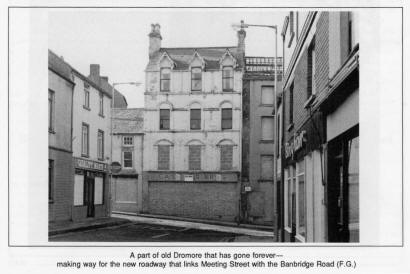
 |